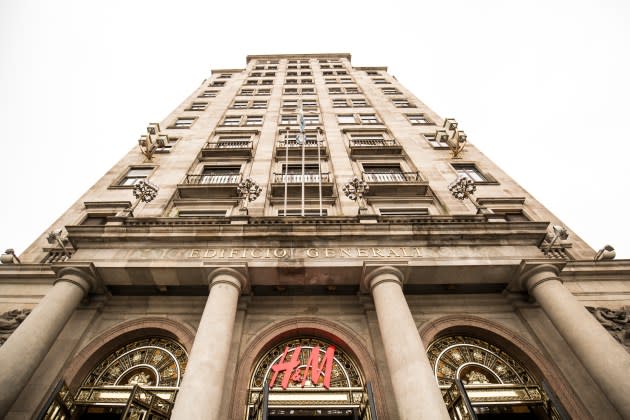H&M Group Q3 Sales Flat as It Cuts Inventory, Costs

PARIS — H&M said it would reopen its stores in Ukraine in November, after shuttering its outposts there in February 2022, following the Russian invasion.
“We’ve maintained a close dialogue with different stakeholders. We are now planning to gradually reopen the majority of our stores in the country from November onward,” chief executive officer Helena Helmersson said in a conference call with investors.
More from WWD
H&M Backs Sustainable Fashion Prizes at Central Saint Martins
What to Watch: As Aspirational Spending Cools, Designer Collabs Will Heat Up
“The safety of colleagues and customers will always be our first and foremost priority. We take a long-term approach and are working to develop the business,” she added.
H&M has nine stores in the country, including six in Kyiv and others in Lviv, Kharkiv and Odesa. It did not disclose which locations would reopen.
The company also clarified that a previous statement about charging for physical returns was incorrect.
“The part where we stated that we are charging for returns into physical stores, that was a mistake,” said head of investor relations Joseph Ahlberg. “That has never been the case, not in the U.K. or any other market.”
H&M will continue however to charge for online returns, which it has rolled out in test markets including the U.K. and Norway. Ahlberg framed the new policy as an environmental effort to “remind the consumer to be mindful of making returns due to the climate impact” of shipping and packaging.
Any complaints about sizing, fit and product inconsistency that fuel those returns are being worked on, added Helmersson.
Elsewhere, the retailer is feeling the heat.
After blaming slow second-quarter sales on spring rain, the company once again cited the weather as mucking up its sales flow. Group sales remained flat in local currencies in the third quarter, while the fall season was off to a slow start due to an unusually hot climate.
In reported terms, third-quarter sales increased by 6 percent to 60.89 billion Swedish kronor, mostly due to the currency hitting an all-time low against the euro in June. But they remained flat year-over-year in local currencies, at 5.22 billion euros at current exchange.
“The third quarter started strongly with a pent-up demand for summer garments following a cold May in most of our major markets,” Helmersson said. “Having now moved into September, we can see that the start of the autumn season has been delayed as to date September has been marked by unusually hot weather in many of our European markets.”
September sales were down 10 percent in local currencies year-over-year. The group partially attributed that number to the loss of its Russian business, which it reopened last September to offload inventory, then permanently closed in November 2022.
Coats and other warmer clothes have so far stayed on the racks, Helmersson said.
“We expect pent-up demand to come through following a late start to the season, however the weak September figure increases the risk of higher clearance given a shorter selling window for autumn garments,” RBC analyst Richard Chamberlain said in a research note.
Sales at its portfolio brands, including Cos, Monki, Weekday, & Other Stories, Cheap Monday and Arket, were up 10 percent in local currencies in the third quarter.
The company is focused on upping its margins and profits, which were up slightly to 4.74 billion Swedish kronor, or 403.2 million euros, boosted by cost cuts in local markets. The company has slashed labor costs and renegotiated leases down by single digits, all while reducing inventory.
It has tightly controlled its product flow to compensate for supply chain hiccups last year. Inventory was down 21 percent in constant currency from a year earlier. It’s using tech and using AI to streamline its flow and become more responsive.
Helmersson added that while consumers are being “more conservative” against inflation and rising interest rates, the company’s reputation for low-cost clothing should steady it against any economic headwinds, she said.
“This gives us room to maneuver on price,” said chief financial officer Adam Karlsson. “We’re well-positioned at the moment where the consumer will be more careful when spending money…and with the improved sourcing situation we also see the possibility for price decreases moving forward.”
All that positive cash flow is being used to snap up its stock, and the company will buy back 3 billion Swedish kronor worth, or about 257 million euros, of its own shares.
Like other big retailers, H&M is being impacted by shrinkage in the U.S, which “continues to increase as it has been over the last couple of quarters,” Karlsson said. “From the U.S. market it is a growing concern.”
H&M brand’s beauty division, which launched two trial stand-alone flagships in Norway in the second quarter, has received “good feedback” by customers, Helmersson said, while stopping short of disclosing sales for the concept.
For the first nine months from Dec. 1 to Aug. 31, sales were flat in local currencies, while up 8 percent to 173.38 billion Swedish kronor, or 14.9 billion euros at current exchange. The flat sales number is in contrast to Spain’s Inditex, parent company of fast fashion rival Zara, which reported first-half sales gained 16.6 percent.
H&M is expanding into Brazil, where it will open its first store next year. It’s also trying to reestablish itself in China, where it returned to the sales platform JD.com after being booted in 2021 following a controversy over Xinjiang cotton. The brand closed its first and largest flagship there in June 2022.
Best of WWD

